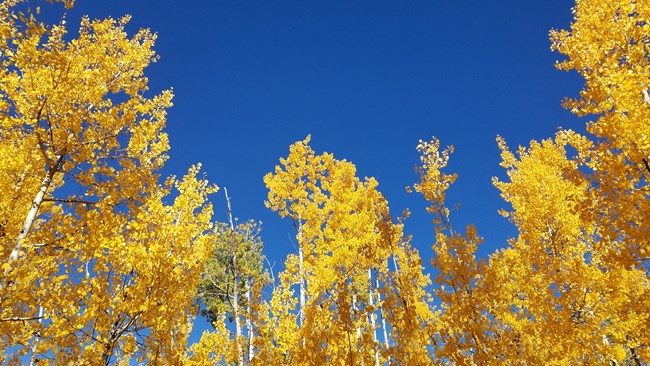
NPS photo
Why We Care
Quaking aspen (Populus tremuloides) is one of the most widespread deciduous trees in North America. Unfortunately, aspen are declining rapidly across the continent due to a suite of many threats, including climate change, drought, pest infestations, and browsing by native and nonnative ungulates. Aspen decline is particularly calamitous since aspen clones are among the most biologically rich plant communities in the Intermountain West and act as a keystone species- or species on which other species depend, and without it the ecosystem would change dramatically (Kay 1997). Aspen stands provide forage for wildlife and domestic livestock in western landscapes, and declining aspen habitats has been shown to result in losses of vertebrate species and vascular plants as well as invertebrates and nonvascular organisms (Campbell and Bartos 2001).
In Great Basin National Park (GRBA) aspen trees are common: approximately 27% of the area within GRBA is mapped as aspen woodland (Provencher et al 2013). In Parashant National Monument (PARA), aspen comprise a small percentage of the land cover, yet the community type contributes to species diversity and richness in the Monument.
Natural History and Culture Significance
Aspen reproduce through seeds and vegetative root suckering, meaning that one tree can extend its roots to create clones. From a scientific stance, these clones make it challenging to define what exactly is an “individual” (e.g. is a tree an individual? Is the whole stand of clones an “individual”?). In addition to being ecologically fascinating, aspen are an attraction for campers, naturalists, and recreationists in the otherwise semi-arid landscapes of GRBA and PARA. Visit the GRBA website to read about arboglyphs in aspen forests, a practice started by Basque sheepherders in the late 1800s.
How We Monitor
MOJN based this long-term monitoring effort on the aspen monitoring plan conducted by neighboring network, the Upper Columbia Basin Network. Aspen stands are monitored in two Mojave Desert Network Parks, Great Basin National Park and Parashant National Monument. The monitoring effort asks the following monitoring questions:
- Are the aspen populations stable, declining, or increasing?
- Are aspen clones regenerating and at what level? What is the long-term trend in regeneration of park aspen populations and in individual stands?
- What is the density of live and dead aspen stems? Is the live and dead stem density declining or increasing in the parks and in individual stands?
- What is the status and trend in conifer density within aspen stands?
- What is the variability of regeneration in plots within an aspen stand and between different aspen stands?
Reports and Publications
Monitoring protocols describe why and how we collect, manage, analyze, and report monitoring data about the network's Vital Signs. Each protocol consists of a narrative and an associated set of standard operating procedures (SOPs).Monitoring reports, as they are developed, will summarize data and findings from our Vital Signs monitoring activities and will also be available here.
Source: NPS DataStore Collection 4466 (results presented are a subset). To search for additional information, visit the NPS DataStore.
Source: NPS DataStore Collection 8024. To search for additional information, visit the NPS DataStore.
Articles
Literature Cited:
Campbell, R. B., and D. L. Bartos. 2001. Aspen ecosystems: Objectives for sustaining biodiversity. Pages 299-307 in Sustaining aspen in western landscapes: Symposium proceedings. USDA Forest Service Proceedings RMRS-P-18. June 13-15, 2000, Grand Junction, Colorado.
Kay, C. E. 1997. Is aspen doomed? Journal of Forestry 95(5):4-11.
Provencher, L., T. Anderson, G. Low, B. Hamilton, T. Williams, and B. Roberts. 2013. Landscape conservation forecasting™ for Great Basin National Park. Park Science 30(1):56–67. Available at: https://www.nps.gov/subjects/parkscience/index.htm.
Last updated: December 6, 2023
